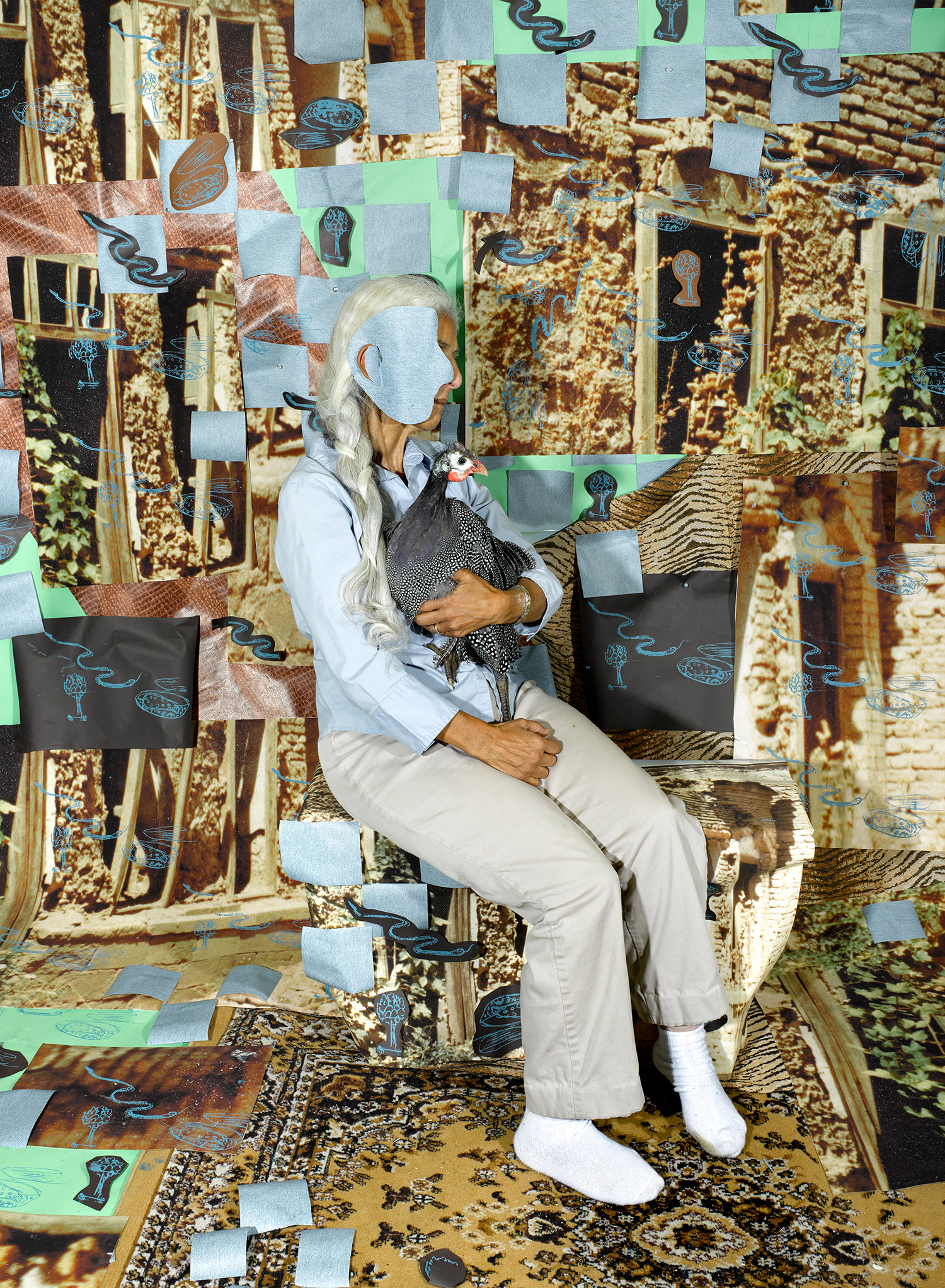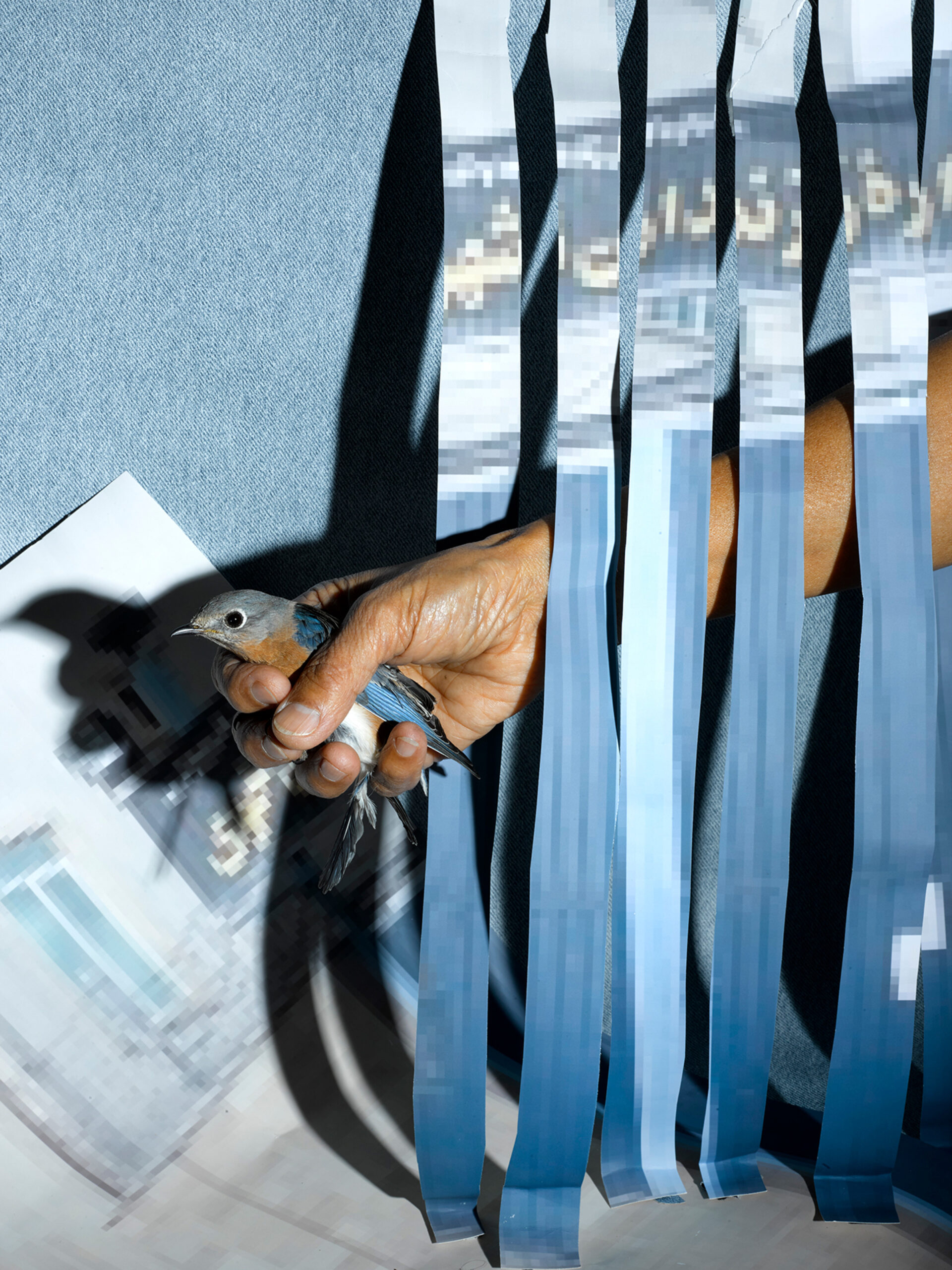Her parents survived prison and separation to flee Iran. Her art tells their story
Photographer Sheida Soleimani’s sumptuous collages reveal dark truths about exile and trauma

Lilah Raptopoulos MAY 3 2023
Sheida Soleimani sits with me in the back of a gallery in Tribeca, New York. Behind us are some pieces of her earlier work, but we’re gazing, on a laptop, at images of her newest. Specifically, we’re looking at a photograph she took of her mother, sitting on a bench, in loose chinos and socks. You can’t see her face; it’s covered. She’s holding a live guineafowl.
Like much of Soleimani’s work, the scene is hard to describe — part collage, part sculpture, part set design. She constructed it in her studio out of layers and layers of actual stuff: blue paper squares pinned to the wall in an imperfect grid; her mother’s sketches of snakes and trees and bread screen-printed and pinned up. There’s animal print, there’s a Persian carpet and, in the middle, there’s her mother.
This is Soleimani’s style: she builds a set, then photographs the scene with a wide depth of field. Because everything is in focus, it’s hard to tell what’s “real”. The resulting images look almost Photoshopped, but they’re not.
Most prominent in this montage of memories is the one of a dilapidated house in Shiraz, Iran. This is definitely real: it used to be her mother’s. Soleimani’s parents fled Iran in the 1980s, after the Islamic revolution. Both were pro-democracy activists who couldn’t stay. Her father was in hiding for nearly three years, then hired smugglers to guide him through the mountains to Turkey on horseback. When her mother tried to follow, she was caught at the border, imprisoned for over a year and put in solitary confinement.
 Noon-o-namak (bread and salt), 2021 © Sheida Soleimani. Courtesy Edel Assanti. Photo by Andy Keate
Noon-o-namak (bread and salt), 2021 © Sheida Soleimani. Courtesy Edel Assanti. Photo by Andy Keate
 Khooroos (rooster) named Manoocher, 2021 © Sheida Soleimani. Courtesy Edel Assanti. Photo by Andy Keate
Khooroos (rooster) named Manoocher, 2021 © Sheida Soleimani. Courtesy Edel Assanti. Photo by Andy Keate
This is the woman who sits there, gently cradling a bird. In the companion image, her husband sits in the same set but faces the other way, towards her, clutching a rooster to his chest. The rooster represents a real rooster back in Shiraz who loved him: the family joke was that if the government ever came to find him while he was in hiding, the rooster would give his location away.
Soleimani, now 33, was born in Indianapolis, Indiana, where her parents finally found a new life. They had no Iranian friends in the Midwest, so she grew up hearing her parents’ tales. “I think they really needed someone to listen, and a child is a captive audience,” she says. “These were my bedtime stories.”
Her latest exhibition, Ghostwriter, is the first time Soleimani is telling their story. In the past, she drew on this history, but her work was political. In 2018 she focused on US dependence on oil in the Middle East. In 2019 she took on Iranian leaders: a piece called “Unplugged”, which we look at in the gallery, is a collage of Iranian protesters, partially covered by a massive printout of Ayatollah Khomeini. He’s mounted on foam-board like a bust. An electrical socket covers his eyes, a plug dangling out.
Soleimani creates these tableaux mostly in her studio in Rhode Island, not far from where she teaches at Brandeis University in Massachusetts. “I want them to be sumptuous, like advertising imagery or food photography,” she says. But look closer; that same thing that drew you in is actually a dead dictator’s severed arm, or a half-naked Dick Cheney wrapped in a $100 bill.
After Covid, something changed. Soleimani worried about her parents’ mortality. She remembered that her dad always wanted to hire a ghostwriter to write a novel about their exile. So she called them and asked if she could ghostwrite their story, in photographs. They said yes, with two conditions. One, that she obscure their faces to protect them. Two, that they be involved. “Baba,” her father told her, using his nickname for her, “you have to discuss with me every single idea that you’re thinking.”
Soleimani agreed. The family are natural collaborators. As a child, she and her mother would draw and make toys. Her mother was a nurse in Iran and, in America, she began rehabilitating birds, making splints for their little legs out of toothpicks. She taught Soleimani too.
 Crying Quince, Laughing Apple, 2022 © Sheida Soleimani. Courtesy Edel Assanti. Photo by Andy Keate
Crying Quince, Laughing Apple, 2022 © Sheida Soleimani. Courtesy Edel Assanti. Photo by Andy Keate
 Khoy, 2021 © Sheida Soleimani. Courtesy Edel Assanti. Photo by Andy Keate
Khoy, 2021 © Sheida Soleimani. Courtesy Edel Assanti. Photo by Andy Keate
Her father, a Marxist intellectual, talked ideas at the dinner table. She describes him as urgent, a man who walked around with his fist clenched in his pocket. In 2018, when the journalist Jamal Khashoggi was abducted in the Saudi embassy in Istanbul and murdered, her father called her. “They cut his body limb by limb with a bone saw,” he said. “I’m going to buy you a bone saw so you can make a photograph.” Her mother then drew a sketch of what the finished work could look like, with the swords on the Saudi flag replaced with bone saws, and sent it to her in the mail. “We have this really intense practice, and back and forth,” she tells me. “It feels like they’re actually getting to tell their own stories too.” The last time she had her parents in the studio, her mother kept moving things around as she prepared to shoot. “How’s this shadow?” she’d ask. “What about this?”
——
Ghostwriter feels like a storybook without words, like walking through fragments of a family history you’ll never fully understand. We see her father’s hand holding the suitcase he escaped with through the mountains, surrounded by the Persian pomegranates that her mother brought with her as seeds. There’s a blue door, with combat boots poking out and a snake winding around them, evoking her parents’ memory of the government coming for her father.
“As I try to piece together these memories, I realise I’m learning what Iran is like through the eyes, lenses and memories of two extremely traumatised people,” she says. What she craves are not feelings but details: did the horse her father rode over the mountains have a name? (“He said no.”) Who were the smugglers? (“He doesn’t know!”). She wants to know specific memories of her mother’s life in prison. Sometimes she gets them.
Soleimani pulls up another image from Ghostwriter. It’s a close-up of her mother’s arm, protruding from a photograph of her prison that has been cut into strips, like bars. She’s cradling an eastern bluebird that she and her daughter had nursed back to health. The day Soleimani assembled this scene, her mother remembered a poem she’d written in confinement, about being a trapped bird. She wrote it down in Farsi, and Soleimani screen-printed it on top. Making this work must be emotional, I say. Soleimani nods. “Cathartic. There’s been a lot of crying.”
Soleimani’s life outside the studio is wild and full. She and her partner live in a big Victorian house on the outskirts of Providence with 22 chickens, eight ducks, two partridges, two quails, pigeons, the guineafowl, two crows (“my children”), four cats, a Great Dane, an 18-year-old tarantula and more than 200 tropical houseplants. Like her mother, she is a licensed animal rehabilitator. Injured birds are dropped off at her home daily. It is a relief from the art world, she says, which can be beautiful but toxic. It also allows her to consider the ethics of taking care. “These animals can’t communicate. So I have to make choices for them.”
Before we leave, I ask Soleimani what she’ll do next. “I could work on this series for a really long time,” she says, raising her eyebrows. “Maybe the rest of my life?”
She imagines Ghostwriter in 15 parts, with offshoot chapters: the stories of women who were in prison with her mother, say, or her father’s friends who were executed. “I’m not ready to go to these places yet, but I envision that I will.”
With that, she rushes back to Providence. There’s an injured hawk making its way to her home, and it needs her.
“Ghostwriter” is at Edel Assanti gallery, London W1, until May 13 and at the Denny Gallery in New York in September
